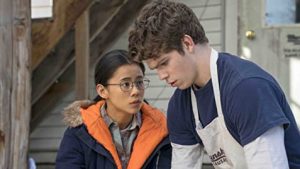72
The Impacts of Subtlety in The Half of It (2020)
By Kyra Cole
Alice Wu has brought yet another movie that evaluates issues of identity in more ways than one. In short and lacking detail, the movie stars Ellie Chu who is an intelligent high school student who is paid to write love letters by a jock named Paul Munksey. The letters are all directed to his crush aka the intelligent and popular kid, Aster Flores. Each character is an outsider in their own right. Paul Munksey was labeled as the slow kid with a large family. Ellie Chu is an immigrant in a primarily white town and is queer in a traditional religious town. Lastly, Aster Flores is the only other immigrant shown in the film. She is popular among the students purely because of her beauty but is looked down upon because she is Hispanic and not wealthy. This is a very simple film that has a lot of twists that relate to the human identity which makes it a fun and interesting movie. This film explores the realm of varying sexual identities, backgrounds, as well as social statuses in relation to race and wealth.
The movie explores the issues that older and young immigrants have to face as well as addresses LGBTQ+ issues in the subtle visual design seen throughout the movie. This makes this film a prime example of how current times can change the path films follow. The cliche romantic-coming-of-age story is changed to just a coming-of-age story about self and platonic love. The characters are learning to bypass the religious environment they live in but in modern-day films like this one, the religious themes are significantly less inviting (Anker). Whether it is living in a closed-minded community or dealing with prejudiced people on the daily, this film expresses these matters fluidly without hyperfocusing on the issues that make people individuals.

The moment the first scene plays, it is obvious that this town is not the most diverse. The small town of Squamish in the state of Washington is a traditional religious community. Meaning that there is still pressure to marry at a young age and not for love. The unmoving belief that “man shall not lay with man”, and the inherent racism that tends to be a part of the secluded predominantly white towns. The main character, Ellie Chu, is an independent and talented Chinese immigrant. She moved to America when she was five years old with her family so her dad can get a better job opportunity. For them, Squahamish was, as she put it, “a stepping off point” until they had a better opportunity. However, as she recounts her story to Paul in the movie, it is revealed that Ellie’s father speaking English well, trumps having a Ph.D. in Engineering when applying for a job. This is just one of many moments where the audience realizes that this movie is much more than just a teen romance.
These characters have depth and diverse backgrounds as well as personalities that many movies featuring queer and BIPOC characters don’t have in other films. Many times films have their queer character or BIPOC character and that is all they are. In this film, their sexuality and race is not the main reason for the character. This film may be centered around high school and contains the drama that one regularly sees but also goes into the depths of discrimination in the younger age groups while still relating it to the older age groups. One example of this is Edwin Chu. Though there are other subtle examples of racism towards the teenagers, Ellie’s dad is a prime example of an immigrant coming to America for a better opportunity.
There was a scene where he was telling Paul, who does not speak mandarin, his story in his native language. He had a heartfelt monologue in his native language and it was directed towards the audience who can read the subtitles or understand mandarin. He was explaining the experience he has had as an immigrant father of a teenage girl, his story is full of loss and uncertainty since he lost his wife and had to raise Ellie alone all while losing the job he moved for and mourning the loss of his life partner. He never learned English fully thus prohibiting him from paying bills on time due to his accent as well as joining the community and making friends because of his lack of wealth and proper English. There are also many examples of microaggressions from the younger peers towards Ellie. Such as the group of boys driving by Ellie riding her bike, screaming “choo choo” or simply calling her the “Chinese girl”. Instead of blatantly showing racism as everyone learns it in history class, this film shows what everyday life could be like for an immigrant and a teenager of color in high school. People can live day to day and not realize they can be racist with “teasing” instead. However, reality is that microaggressions are extremely common in our day-to-day life.

DPD is representative of all types of differences and discrimination. The main character, though she is intelligent and talented, was in this country. The community that she lived in did not treat her well and assumed the stereotypes that went along with her race. In other words, since she is Asian, she must be intelligent. Though she was intelligent and did write other students’ essays for them for a price, she was always considered an outsider and never part of a group. This went for Astrid Flores as well. Although she was part of a group, she was constantly reminded that her presence in the group was a privilege and that since she wasn’t as wealthy, she was lucky to even be a part of their group. Despite the prejudices seen in this film, Paul is representative of someone who grew up in environment but “when exposed to various ethnic groups and the queer environment, these prejudices are broken down” (Yuen). This is seen at the end of the movie where he went from, “you’re going to hell” when he found Ellie liked Aster who he had liked as well, to defending her at the church and helping her dad when she was working.
As for visual design, throughout the entire movie, the placement of the characters as well as the environment around them showed just how their relationships were building and how each character was isolated due to many different reasons. One example of this is when Ellie and Paul were striking a deal about the love letter he was paying her to write. They were inside an abandoned train and even then they were separated by a line of seats. Throughout the rest of the movie, they were separated by a net on the ping pong table or they were in a confessional booth with a wall in between. This was to symbolize the fact that Ellie was an outsider while Paul was in line with the community at large. Paul stood for everything the town believed in, such as religious beliefs or social standing beliefs. However Paul, unlike the others, was open-minded and the audience realized he was acting upon what he was taught, not what he will soon believe in. An example of this is when he realizes Ellie likes Aster and he says, “you’re going to hell”. Instead of being angry and thinking she deserved it, he was sad and frustrated that this could happen to a friend and the audience could tell that those words were said with a heavy heart. They had stopped talking for weeks until he did his own research and stood up for her when it mattered most. Despite his character having a religious background like most characters in this film, “characters can’t be ‘too good’ or ‘too evil’ and must struggle with the same choices common to most people” or otherwise known as the balancing act in films that is an attempt to mirror reality as expressed by an anonymous reviewer. This shows that despite beliefs, there is room for change and acceptance.
I chose this film because of its representation of both the queer community and people of color. Not only did it include both but it also did it in a way where it can be directed to young people, who need representation in their lives, as well as make the characters relatable and entertaining for everybody. This is also one of the few films where it doesn’t end in the guy getting the girl or the girl getting a girl, it ends with everybody getting something they had needed in their lives rather than wanting. Paul gets to have a say in his family’s restaurant, while Ellie gets to go to college and leave the small town of Squamish, and Aster gets a chance at Art School even though she previously gave up art. This film gave me hope for films in the future to have something other than the cliche romantic-coming-of-age story as well as more of a representation in films regarding race, sexuality, and disabilities. It is also important for films to be directed by people from these groups so that representation can be accurate. This film was directed by Alice Wu who is an Asian American, she had designed this movie to be inclusive and has successfully done so in a time where “most images of Asians and Asian Americans on screen weren’t created by Asians or Asian Americans, but by people who don’t know much about them” (Schacht).
References
Anker, Roy M. Beautiful Light Religious Meaning in Film. William B. Eerdmans Publishing Company, 2017.
Bloodsworth-Lugo, Mary K., and Dan Flory. Race, Philosophy, and Film. Routledge, 2015.
Yuen, Nancy Wang. Reel Inequality: Hollywood Actors and Racism. Rutgers University Press, 2017.
Schacht, Kira. “What Hollywood Movies Do to Perpetuate Racial Stereotypes: DW: 21.02.2019.” DW.COM, 2019, www.dw.com/en/hollywood-movies-stereotypes-prejudice-data-analysis/a-47561660.

